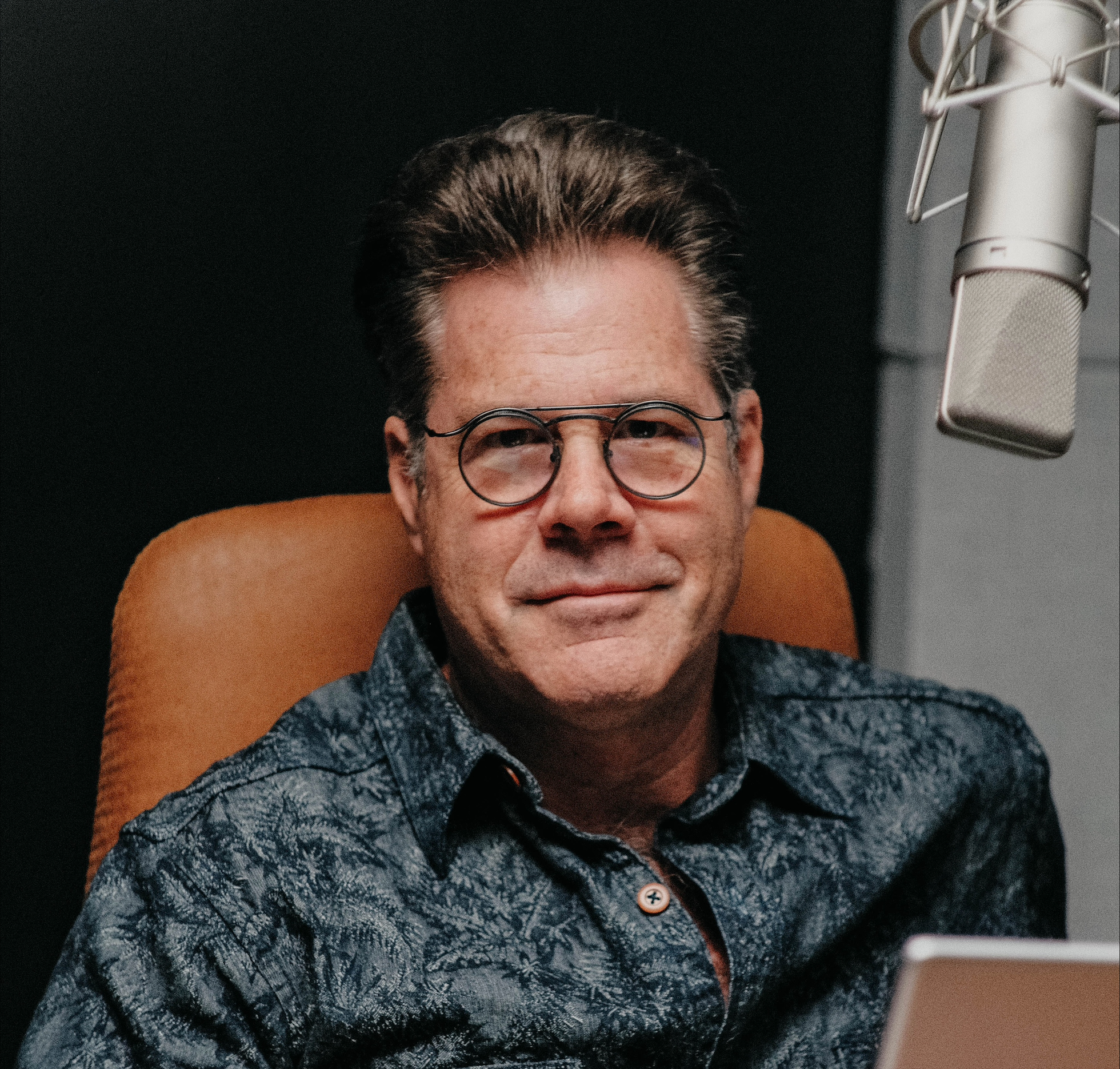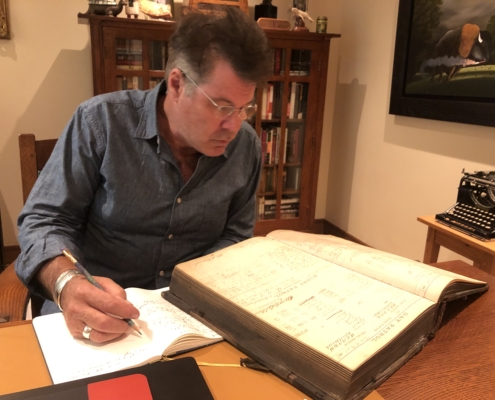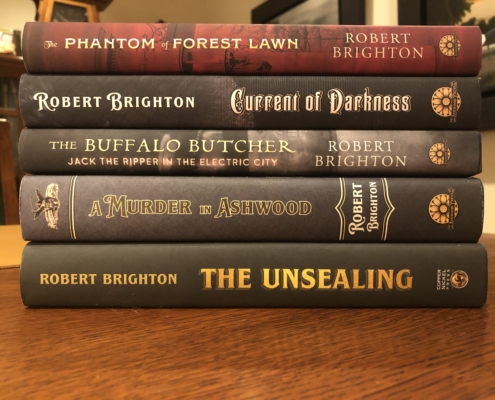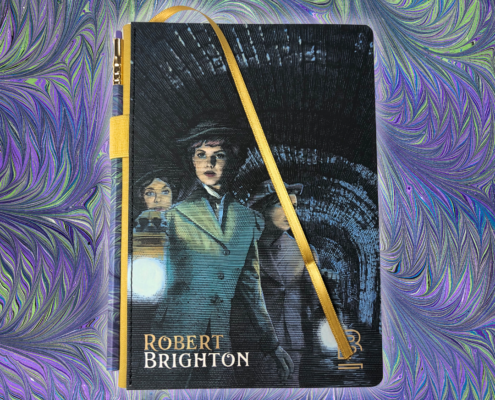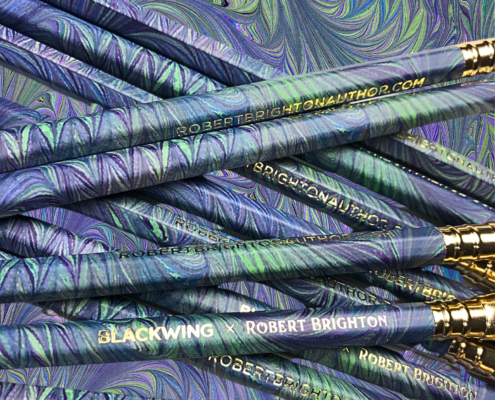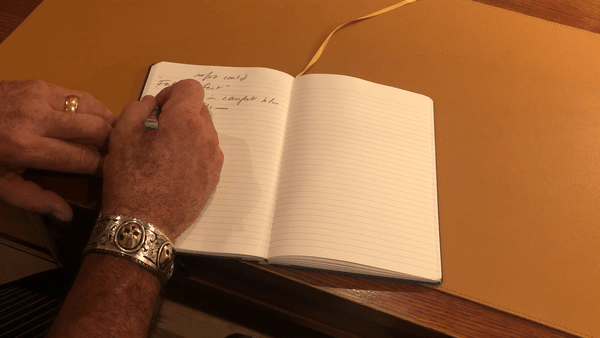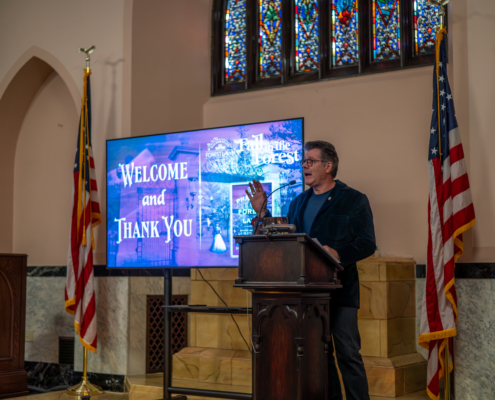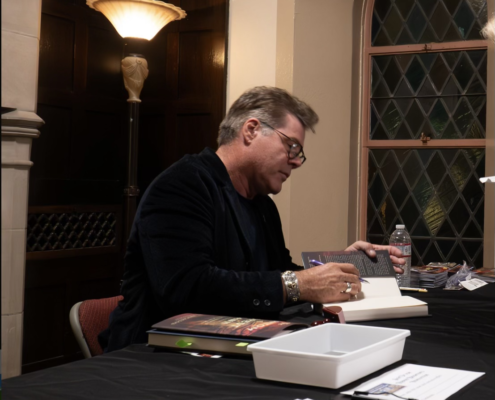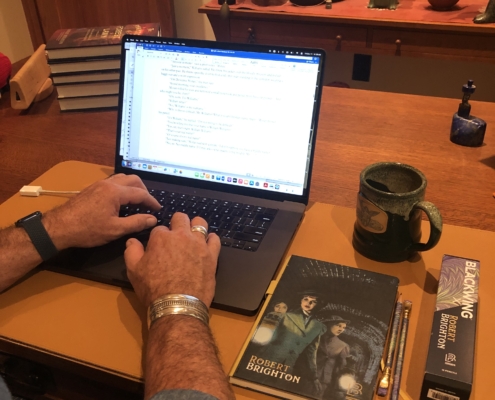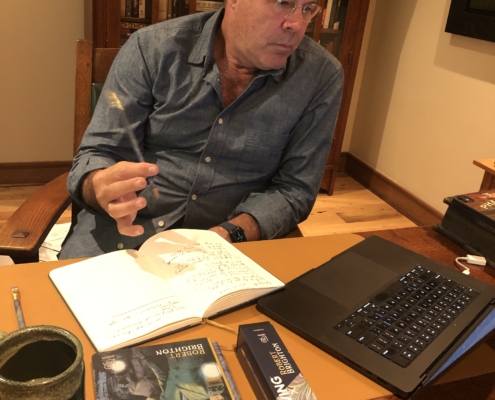Name: Robert Brighton
Pencil Hand: Right
Craft: Author
Location: Northern Virginia
Shop Blackwing x Robert Brighton:
robertbrightonauthor.com/shop
“…good books will take readers anywhere they want to go—but great books will take them places they didn’t expect.”
THE PROCESS
We had the opportunity to chat with Robert Brighton, award-winning author and creator of the Avenging Angel Detective Agency™ Mysteries and other acclaimed titles. He is an expert on the Gilded Age and avid Blackwing user. We recently teamed up on a Bespoke collection celebrating the release of his book Current of Darkness.
How and when did you decide to become a writer?
Mainly, I think it’s what I always wanted to be—it was a kind of calling, or obsession if you prefer. When I was a kid, books took me to countless places I wanted to go. I suppose as I grew up, I wanted to do for others what all those authors had done for me.
That said, it took many years for me to gain control of this craft of writing (or art, or both) before I was willing to publish a single word. I wanted to set the bar high, because I believe that good books will take readers anywhere they want to go—but great books will take them places they didn’t expect. That was my goal.
What drew you to historical fiction? And why the Gilded Age in particular?
Historical fiction authors can get a little heady about the ‘lessons of history’—and while I do not dismiss thought-provocation as a valuable byproduct of reading historical fiction, to me the author’s primary duty is to tell a good story. And what makes a good story? I tend to think that people read historical fiction to immerse themselves in a different time or place, either as a few hours’ escape from the daily grind or simply because it’s easier to immerse oneself in another era because our modern thoughts about modern life don’t keep intruding on our enjoyment of the story. Thus I feel that a rich and historically sound recreation of the world of the past—with a fictional gloss—provides a very satisfying reading experience. Readers of my books can wander around in the Gilded Age with me for as long as they like, and then come safely home again.
As to the Gilded Age itself, I suppose to me it represents the last gasp of a world now utterly swept away—whether in mindset or simply in the way people lived their lives. In the fifty or so years after the Civil War, most Gilded Age people evolved a belief that the future would be always better than the past. To them, the evil of slavery had been atoned for by the bloodletting of the Civil War; every day brought a new technological or scientific marvel; the last blank corners of the map were being explored. And in only a hundred years since…that sense of optimism has mostly curdled. Humanity cannot turn away from the sinking of the ‘unsinkable ship’, the Titanic; World War I, the Great Depression, the resurgence of the Klan and Jim Crow, World War II, the Holocaust, Stalin, Mao, Pol Pot—really, do I have to go on? The short century following the conclusion of the Gilded Age—our century—has been one of nonstop horror. Even all of our modern technical marvels seem only to have deepened the sense of alienation we have from ourselves, our fellow human beings, and from nature itself (I have seen people at the rim of the Grand Canyon spending the whole time on their phones).
As a result, I tend to think that the Gilded Age was a little like those halcyon days of childhood, when we could hardly wait to grow up. Until we found out what growing up means! In the Gilded Age, almost no one could imagine what was just ahead, but man-oh-man were they barreling full-steam toward it! In my own moments of optimism, I like to think that perhaps understanding all that might help us pump the brakes a little. Or not: Human nature hasn’t changed in a mere hundred years, and if there is anything in general about Homo sapiens I can state with confidence, it’s that it is an unusually violent, horny, and greedy species. If this be treason, make the most of it!
What is the Avenging Angel Detective Agency?
The Avenging Angel Detective Agency is a fledgling (fictional) detective agency founded by beautiful young widow Sarah Payne. When Sarah’s intended is murdered at the behest of some very powerful people, the murder is immediately swept under the proverbial rug. Like most of us, Sarah might have gone on with her life with a degree of resignation about ‘the way things are’, but that’s not in her nature. She grew up reading the Sherlock Holmes stories of Sir Arthur Conan Doyle, and always thought she’d like to become a detective herself. And so she resolves to do for her dead lover what the justice system could not or would not do—hold the guilty parties to account. To right this kind of wrong, she starts up a detective agency to be a kind of ‘avenging angel’ for people to whom justice has been denied.
Part of what makes Sarah and her detective exploits unusually charming is that, while in deadly earnest about her new profession, she knows absolutely nothing about being a detective—except what she’s read in books. But unlike the unerring, cold precision of her hero Holmes, in her naïveté Sarah makes more than her fair share of mistakes and misjudgments. Even so, and against much opposition, she refuses to abandon her belief in herself, and that women can compete on equal footing with men, which of course was a pretty revolutionary notion at the time. I think all that makes her a very real person, and if there is one word that in my opinion ought to define good historical fiction, it is ‘verisimilitude’. That’s what I aim for; and with Sarah (and her ‘best frenemy’ Alicia Miller) I believe I hit the bullseye. Now there must be truth in advertising, so I must add that while my books do provide a kind of ‘escape’, they are decidedly not nostalgic. They depict the times and the human condition in the way my research has found them to be, warts and all.
You’ve published two books this year. What can you tell us about these novels?
Current of Darkness (published earlier this year) is a story of industrial espionage set in 1903 Niagara Falls, New York, at the dawn of the electric power industry. Mysterious tycoon Charles Kendall depends on the falling waters of Niagara to spin his turbines and make his product. But little by little, his water is going missing—and with it a great deal of profit—and he asks Sarah Payne to come to Niagara Falls to solve this mystery. This brings Sarah into contact with shady union bosses, dangerous anarchists, and people who will stop at nothing to win. And, I don’t mind saying, a few sparks fly between Sarah and Charles . . .
My latest book is called The Phantom of Forest Lawn, and while I won’t give any spoilers away, let us say that it is a novel of love and grave-robbery. Now, those things don’t usually go together, but suffice it to say that they do in this book! I’m very proud of it, and I think anyone who has ever loved or lost—or both—ought to read it.
How did you discover Blackwing?
Many years ago (more than I care to admit), I fell in love with pencils. It may have been as a child, because in those days every classroom had a pencil sharpener next to the blackboard, and I recall so very fondly the sharp tang of ground cedar and graphite that oozed out of it! (The sense of smell, you know, is the one most closely linked to memory.)
As it is in my nature to seek out the best tools for any job, when I started writing in earnest I tried many different vintage pencils—and there are some great ones. But none, I found, wrote and felt like the Eberhard Faber Blackwing 602, which alas was long out of production by the time I discovered it. Yet for a struggling author without much disposable income, a $50 vintage pencil could be only a very occasional splurge! Then quite out of the blue, CalCedar resurrected the Blackwing brand, and while I will admit I was at first skeptical that a modern version could ever live up to the standard of the original 602, boy did I turn out to be wrong. I quickly found that the ‘reimagined’ Blackwings were every bit the pencil that the old ones were. And, by the way, that I could buy a whole dozen of them for less than the cost of a single vintage 602! I guess you could say, then, that I have always used Blackwings—and I’m very grateful (no kissing up here, either) that you guys brought them back into my life, and at a price point that makes them a very affordable luxury.
We hear youʼve written all your novels by hand. Can you explain this part of your creative process?
I’d love to claim credit for such a feat, but even a graphite-head like me couldn’t manage that . . . my fingers would fall off if I had to write and rewrite a hundred-thousand-word novel longhand. I know lots of writers have done just that, but that was before laptops! Now what I do do is to take all of my research notes (and there are a lot of them when one is a historical novelist) in pencil and in Blackwing’s Slate™ notebooks. When I have story ideas, I work them out first in pencil. Only after I have done all that will I open the laptop to write! So while I may not write my novels out longhand, none of them could have been written at all without the good old pencil.
Do you have a preferred pencil or graphite for drafting your novels?
I have a heavy ‘hand’, whether on the keyboard or on paper, and as a result I tend to favor Blackwing’s Firm or Extra-Firm lead. I don’t have to sharpen nearly so much. (By contrast, my wife is a graphic artist, and she favors Soft or Balanced.) In traditional graphite terminology, I prefer something around a #2 ½. Lots of vintage pencils have curious variations on that theme—2 3/8, 2 5/8, and so on—and if I had to choose a few vintage models (other than the 602), I’d choose the Eagle Diagraph 817 (early 1900s), Dixon’s Mikado/Mirado (circa 1930s and later), and the Richard Best Futura (1950s). It’s fun to see how different pencils perform, but I’ve always come right back to Blackwing. I almost feel like I’m cheating on Blackwing when I use anything else!
How would you persuade a friend to choose a pencil over other writing tools?
There is something inherently forgiving about the pencil. Its erasable nature eliminates the pressure to be perfect—in fact, pencils encourage trial and error. Furthermore, there is a contemplative aspect to writing in pencil: the feel of the wood and the scent of the graphite as they are warmed by the hand, and the quiet, the uninterrupted flow of ideas without a blank screen staring accusingly back at me. If I can’t think of an idea, I can doodle and let my mind drift, which I cannot do on a laptop. In my opinion, a major cause of the dreaded ‘writer’s block’ is the notion that one can sit down at a laptop and start creating something where nothing has been before. That is daunting.
Also, since I live in Northern Virginia, I spend a great deal of my research time at the nearby Library of Congress, whose collection is unequalled—and guess what? The Library allows only pencils into their reading rooms—because rare manuscripts and books can so easily be ruined by a single errant stroke of a pen. If someone makes a bonehead play and marks up a book with pencil, it is easily erased without doing any lasting damage to something that is itself a piece of history. Pencils are a respectful way to approach valuable research materials.
We collaborated on a set of Blackwing X Robert Brighton pencils and Slate notebooks for your recent book launch. How did you approach the design of these assets?
With considerable excitement, and more than a little fear! Imagine if you will a graphite fiend and Blackwing loyalist like me, being asked to design his very own pencils and notebook collaboration. Blow this, Robert, and you’ll be the laughingstock of Pencil World forever! In all seriousness, though, the principle I followed was to design a pencil and notebook that I would pick up and use before any of the many others squirrelled away in my house. To do that, I thought about what (to me) makes for a perfect writer’s pencil and notebook, and one good enough to share joyfully with others. As it happened, the design came together in more or less the same way my books do. I try to write stories that readers will enjoy, and I tried to design a pencil and notebook that pencil aficionados would enjoy using. (Perhaps even to launch their own writing careers!)
For the pencils, that meant something that looked beautiful and wrote marvelously well. For the barrel I selected a vintage Victorian marble paper design like those used in fine books of a century or more ago, in swirling shades of blue, green, and purple that would never be ‘sharpened away’ like some designs can be. For the lead, I chose Blackwing’s Firm, which as noted I find for a writer (and inveterate doodler!) has the perfect blend of buttery smoothness and durability. I neither find my hand getting fatigued after hours of writing, nor am I required to halt my train of thought for frequent resharpening. The ferrule had to be gold, of course, since my books are set in the Gilded Age . . . and for the eraser, I chose a custom Pantone shade of violet that matched the color of my heroine Sarah Payne’s deep blue eyes.
For the notebook, I have found the Slate A5 Medium to be perfect for its combination of writing space and portability. On its front cover is the cover art from my novel Current of Darkness, showing my Avenging Angels in a tense moment. (My publisher commissioned the incredible Mark Summers, who is simply the world’s finest scratchboard artist, to do the art.) On the rear cover is the logo of the Avenging Angel Detective Agency. Inside, the endpapers are full-bleed versions of the pencil-barrel’s lovely marbled design. A gold marker ribbon and cloth spine complete the package.
When I was done designing the pencils, box and insert, and notebook, I will admit I was pretty nervous about how they’d turn out! Until, that is, I received the first proof samples in the mail. I am here to tell you (and lying is very bad karma) that since then, my entire pencil collection and my stack of black Slate notebooks . . . well, they just sit there glaring at me, because the only pencil and notebook I want to use are my Blackwing collaborations. Frankly, for an author and a pencil-head, it was kind of a dream come true.
What are you working on next?
My next novel is called Winter in the High Sierra, and it’s due out in early Fall 2025. Between now and then, my publisher plans to release one of my short stories each month as a very affordable, e-book-only way to keep my readers interested until Sierra appears. I’ve found writing short stories to be a lot of fun—it’s such a different craft from novel-writing: harder in some ways and easier in others.
The good news for me is that people still love to read books—and more than I ever dreamed possible say that they love reading mine! Now that I’ve hit my stride, I hope to continue doing this for whatever time I have left in my all-too-brief visit to Planet Earth. To be able to do what you love to do every day is a ‘pinch me’ kind of thing. And knowing I can now do that thing with my very own Blackwing pencils and notebooks gives me enormous pride and pleasure!

